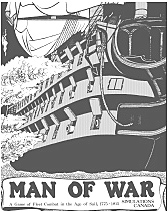 Components
Components
Players 2
Playing time Depends on scenario
Turn 4 minutes
Distance 250 metres per hex
Units Individual ships
Components
1 ziploc bag or box
1 unmounted plain blue standard-issue hexgrid map
1 12-page full size rulebook
400 back-printed die cut counters
SimCan says:
“Man of War is a game type simulation of naval combat between sailing ships in the period from the start of the American Revolution to the end of the Napoleonic Wars. Turns are of variable length and represent up to four minutes. Ships are represented individually, but the concentration of the game system is on actions involving a number of ships on each side, that is, squadron and fleet level actions.
The Reviewer says:
“I found myself thinking back over each game, wondering if I could have maneuvered my fleet better, or whether my squadron composition had been correct ... in short, wondering what any admiral would wonder after a battle. And that is as good a comment as I can make about Man of War. If you are into single-ship actions, stick with Wooden Ships and Iron Men. But if you are interested in fleet actions, Man of War is a game worth a look.” --John D. Burtt in F&M 42.
Comments
Twelve scenarios are provided, from the fleet action off Ushant in July 1778 to the small squadron battle of Lissa in March 1811. Guidelines are provided for player-generated scenarios. The turn sequence is unusual. At the beginning of the turn, all units must have their movement points determined and the number of movement segments is equal to the highest number of movement points in the turn. Following this, the players check each damaged ship in close contact with the enemy to find if it strikes its colors. Then the individual movement segments are played, the results of each segment considered to be simultaneous. After each movement segment, combat may occur. Each ship may fire one or both broadsides at enemy ships in range. Crew quality determines whether a ship can fire multiple broadsides during the course of one turn. Due to the technology of the day, there was no way to co-ordinate the fire of several ships onto a single target, so each ship’s fire must be resolved on the target separately.
The flagships are designated with Flag or Fleet Flag markers. All ships not closely engaged with the enemy are required to move in concert with the nearest flagship, and flagships must do the same if there is a fleet flagship. This duplicates the extremely rigid Fighting Instructions which governed the Admirals of the period. Individual initiative was not encouraged among captains of ships of the line, and an Admiral who allowed his command to deviate from the Fighting Instructions was literally risking his life (a court martial could sentence him to death by firing squad for not following the instructions). Once a flagship is engaged in combat, all ships under the command of that flag are free to engage the enemy.
In summary, I am very pleased with the game: although I have not played all the scenarios, the game results seem to be in line with the historical results. The game does not require huge amounts of bookkeeping for the scale of the action. Mr. Newburg balanced this design very well and, I think, achieved his aims admirably.
Collectors Notes
Boone lists low, high and average prices of 3/8/6.00 at auction and 10/20/ 15.00 for sale.
Errata
None, but the SimCan Newsletter provided an additional scenario:
10.3M, Guernsey, 23 April 1794. In the light of an early dawn these two frigate squadrons met in a fierce action that saw Pellew take three of the four French vessels. A brisk Oceanic wind from the NE.
French Units in section C facing S: (1)44F, (2)36, (1)20. All start within 6 hexes of east edge. Crews: (2)36 Av, rest Pro.
English Units in section G facing NW: (1)38, (4)36, one an F. All start within 4 hexes of the east edge. Crews: (2)36 Av, (1)36F Ex, rest Pro. French units may only exit the map from the south edge.
Victory: The French win an operational victory if at the end of the game at least 3 French ships exited. To win tactically the English must sink or capture at least 70 more guns of ships than the French sink or capture, otherwise the French win tactically.
Steve Newberg says:
This was a very good design. At the time I liked playing minis and had a large collection of lead sailing ships. I had tried every set of rules around, including going back to the board games on the topic such as Wooden Ships and Iron Men and Frigate. None of them left me satisfied. They were all too tactical to really play out the large fleet actions of the late Age of Sail, and most did not really reflect the command situation of the time or accurate sailing mechanics. Man of War was a design I really did for me, and we then packaged it for publication. I was happy with it at the time and still am. It remains the best command level board game on the topic available and it has engendered no less than three later computer game versions, one in house and two by another publisher.
Back to Simulacrum Vol. 3 No. 2 Table of Contents
Back to Simulacrum List of Issues
Back to MagWeb Master Magazine List
© Copyright 2001 by Steambubble Graphics
This article appears in MagWeb (Magazine Web) on the Internet World Wide Web. Other military history articles and gaming articles are available at http://www.magweb.com